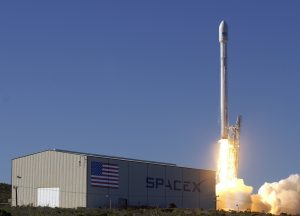New Technology Of Reusable Rockets
The reason that, 50 years after men walked on the moon, you still can’t hop on a rocket shuttle for a week-long trip to Club Med Tranquility Base is that we’ve been doing space travel all wrong for decades.
How Space Travel Involves Throwing Away Most Of The Rocket
Almost every trip into space involves throwing away the launch vehicle after it has been used. This method of lobbing payloads into space has made space travel absurdly expensive, something that only governments and a few large corporations can do on a regular basis.
Imagine what air travel would be like if an airliner had to be discarded after every trip. Nobody but a few government employees and rich people would ever fly.
The Quest For The Reusable Rocket
NASA made a failed attempt to address this problem by building and flying the space shuttle. Currently, two private companies, SpaceX and Blue Origin, are engaged in a race to develop the first reusable rocket, which can take off, land, and then do it all over again.
Aerospace engineers at the beginning of the space age had to wrestle with the fact that it takes a tremendous amount of thrust to put anything into orbit around the Earth. They found a solution to the problem with a technique called staging. To put it briefly, staging means that a rocket is broken up into two or more stages. The first stage boosts the rocket part of the distance and then falls away. Then the second stage fires its engines and takes the rocket another part of the way. Eventually, the satellite or spaceship is in low Earth orbit, and the stages of the rocket either crash into the sea or burn up in the atmosphere.
Around the time men landed on the moon, using the biggest multistage rocket ever built, the Saturn V, engineers at NASA realized that staging and discarding rockets was an absurdly expensive way to travel in space. Thus, the idea of the space shuttle was born.
In theory, the space shuttle was a beautiful concept. It would launch like a rocket and, after having done what it needed to do in space, it would reenter the Earth’s atmosphere and land like an airplane. Then the shuttle would be turned around and reused. The cost of space travel would plummet, and NASA could afford to do all sorts of things in space that hitherto had been too expensive.
To make a long story short, NASA achieved the reusability part of the problem (with the exception of the solid rocket boosters and the external fuel tank, which were discarded.) But the space agency never managed to get the shuttle turned around quickly and cheaply. NASA needed a standing army of thousands of people and months to refit a landed shuttle so that it could launch again. Space travel had not become in any way cheaper.
The Private Sector Succeeds In Landing And Reusing Rockets
Fast forward some decades later, and we see that two companies, SpaceX and Blue Origin, have hit upon new technology combining reusability with staging.
The SpaceX Falcon 9 started as a standard launch vehicle that was thrown away after every flight. Recently, the company retrofitted the first stage of the Falcon 9 to land after it finishes lifting the rest of the rocket into space.
Results have been mixed, thus far. Several attempts to land the Falcon 9 first stage on an offshore platform met with spectacular failure. However, SpaceX did manage to land a first stage on land, close to its launch pad near the Kennedy Space Center. Subsequent tests of the engines of the Falcon 9 hold out good hopes that SpaceX will be able to turn it around and relaunch it relatively easily, as well.
In the meantime, Blue Origin has not only launched and landed its suborbital New Shepard rocket, but it has turned it around and launched and landed it again. The company plans to use the New Shepard to take the rich and adventurous on suborbital joy rides after an extensive flight testing program. Eventually, Blue Origin will scale to an orbital version of its reusable rocket.
The upshot of all of this is that sooner rather than later, ordinary people will be able to travel into space on reusable rockets much the same way they cross oceans and continents in aircraft. Some would suggest that when that happens, the true space age will have at last arrived.









